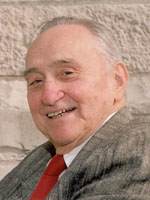
Fred Basolo
Northwestern University
"Cookers" in Chemistry
In the late 1940s and early 1950s the field of inorganic chemistry was dominated by German chemists. My colleagues and I called them “cookers” because they described how to put new inorganic compounds together but never explained how or why the synthesis worked. At the time chemists in the United States were excited about carbon, hydrogen, oxygen, and nitrogen; in other words, they focused on organic chemistry that led to polymers and pharmaceuticals. Already in graduate school, however, I was inspired by John C. Bailar, Jr., one of only a few inorganic chemists at the University of Illinois. During World War II, American chemists working on the Manhattan Project suddenly needed advanced metals, and they soon discovered applications in instruments like X-ray diffractometers and spectrometers. American chemists who returned to their old jobs after the war (I got a teaching and research position at Northwestern University) birthed modern inorganic chemistry.
Assisted by Therald Moeller at the University of Illinois and W. Conrad Fernelius at Pennsylvania State University, Bailar had the idea to start a Gordon Research Conference on inorganic chemistry in 1950. Fernelius served as the conference’s first chair in 1951. Robert W. Parry and I did most of the legwork, submitting application materials to start the conference and seeking out inorganic chemists to attend. Even though there was little funding for graduate students and faculty, in the conference’s first year we attracted sixty attendees, most of whom we already knew.
Parry and I kept attending the Inorganic Chemistry Gordon Conferences because we liked the format. There were talks in the morning and evening, and we played sports or kept discussing our research in the afternoon. I often played tennis before breakfast and golf in the afternoons with Dennis Elliot from the Air Force Office of Scientific Research (AFOSR), Parry, and Parry’s wife, Marj. The combination of great science and afternoons off seemed to be the reason that other Gordon Conferences continued year after year and gave us an inkling that the Inorganic Conference would also continue.
As the field of inorganic chemistry became more important, conference attendance grew quickly to a hundred. International interest also grew, and through his contacts with Denny Elliot, Parry helped arrange AFOSR funding starting in 1962 to subsidize the participation of foreign scientists. The Inorganic Chemistry GRC is still going strong, as the 180 applications to a recent conference show.
Eventually I became involved in GRC management. I was elected to the council in 1970 and then later helped review conference proposals as part of the Selection and Scheduling Committee. I became chairman of the board in 1975. Over the years Alexander M. Cruickshank and I became good friends. We always reminisced about Harold Smith, under whom we had both studied - Cruickshank at the University of Massachusetts and I at the University of Illinois.
The Inorganic Chemistry GRC has always featured a variety of topics. Discussion and lectures during the early years explored crystal growth, inorganic fluorine compounds, and coordination compounds. Discussions about the lanthanides (the “rare-earth” elements) and mass-produced chemicals like ammonia, sulfuric acid, and nitric acid attracted many industrial scientists. Twenty-eight of sixty attendees in 1951, for example, were from industry and nonacademic institutions. Coordination chemistry, my specialty, eventually became a staple topic. In fact, I gave the first-ever lecture of the conference series on “Stereochemical Changes in Reactions of Coordination Compounds.” Over the last half-decade several major fields (and their corresponding GRCs) have come out of inorganic chemistry, including solid-state chemistry, semiconductors, and bioinorganic chemistry.
The year 2001 marked the fiftieth anniversaries of both the Inorganic Chemistry GRC and my participation in it. In those fifty years I missed only six conferences. Looking back, today’s chemists can see how far inorganic chemistry has come: specialties like organometallics, nanotubes, and new materials chemistry did not exist in the early days. Although there are Gordon Conferences in many of the subfields, I continue to believe in the importance of a core general Inorganic Chemistry GRC. It exposes young scientists and established specialists to new topics and different career possibilities. In sum, GRC served as a foundation for inorganic chemistry in the United States and has helped keep a core identity among its practitioners.